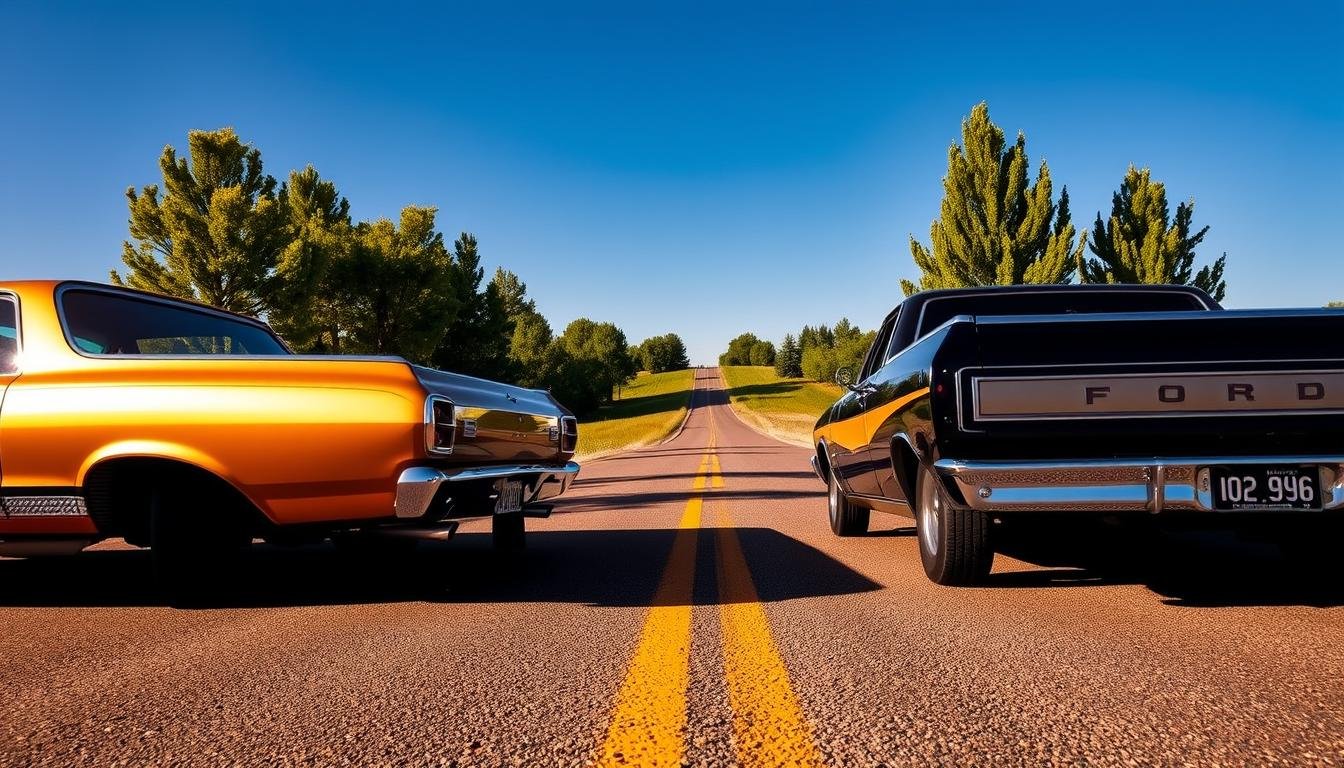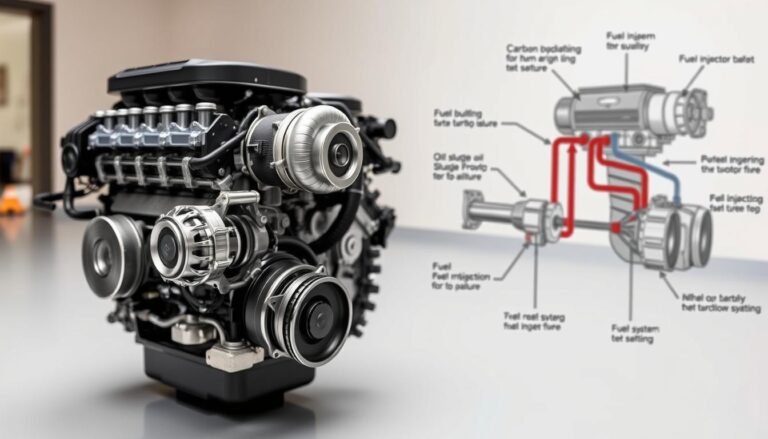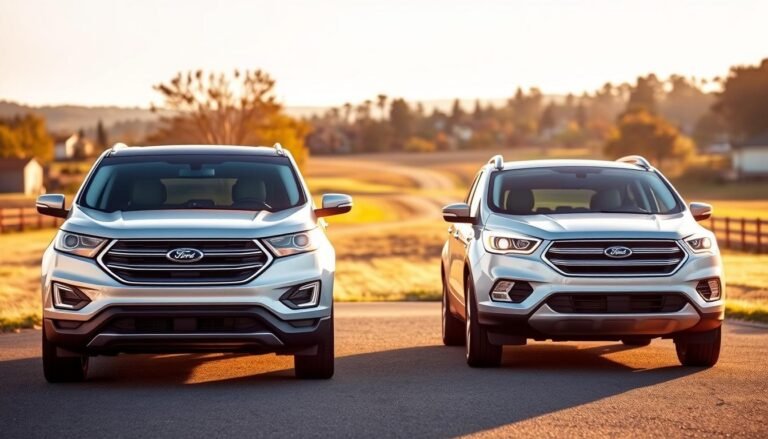Ford Ranchero vs El Camino: Classic Showdown
The Ford Ranchero vs El Camino bring a classic car battle. They are two iconic pieces of American car design.
These models, known as coupe pickups, mix car and truck features in a unique way. This mix is very appealing to fans and collectors.
Let’s dive into what makes these vehicles stand out in American culture. We’ll compare their history, designs, and how they perform.
You will also learn about the community of fans that loves each model. This will show you the unique qualities and details of both the Ranchero and El Camino.
It gives a full view of why some people can’t decide which one is better. Get ready as we take a closer look at what makes these coupe pickups special.
We’ll examine their value to collectors and why they have a big fan base!
Introduction To Coupe Pickups
Coupe pickups, known as car-truck hybrids, combine the ease of cars with trucks’ utility.
They became popular in the mid-20th century, thanks to Ford and General Motors.
These companies aimed to serve different people, from farmers to families looking for versatile vehicles.
Their design offers both function and style, without sacrificing comfort. They have a cargo bed and a comfy coupe-like cabin.
This makes them a favorite across different automotive market segments.
History of The Ford Ranchero And Chevrolet El Camino
The Ford Ranchero started out in 1957. It was a new kind of vehicle that mixed a pickup truck with a car. Ford wanted to offer something both useful and good-looking.
People who needed a versatile ride got exactly that with its stylish front and cargo bed in the back.
The Chevrolet El Camino came out in 1959, adding to the coupe-pickup mix. It took some inspiration from the Ranchero but had its own special look.
General Motors had their touch on it, winning over folks who needed a car for work and fun.
These years were important for car innovations in the U.S. Ford and Chevrolet changed with the times, starting a rivalry.
This competition brought us many cool cars over the years. Both the Ranchero and El Camino changed with what people wanted, marking their spot in the coupe pickup world.
The history Ford Ranchero and the history Chevrolet El Camino show their large impact. They changed American car culture with their mix of style and use.
Both cars are still loved by many, showing the blend of form and function was a big hit.
Ford Ranchero vs El Camino: Design and Body Style
The Ford Ranchero and Chevrolet El Camino have different style ideas. They both blend usefulness with good looks, which car fans love.
The Ranchero went from a big sedan to a smaller size. Meanwhile, the El Camino changed with the times, showing off its unique periods.
The Evolution of Ranchero Designs
The Ranchero’s design has changed with the times and new tech. It started big, based on a Ford sedan, but got smaller to fit what drivers wanted.
Its look got more aerodynamic and bold, appealing to new buyers.
El Camino’s Styling Through The Years
The El Camino’s design took cues from the trendy Chevelle. Its look changed over time, mixing sporty with useful.
The changes, like smoother curves, made it more popular. These updates showed off its speed and kept it appealing and modern.
Ford Ranchero vs El Camino: Engine Comparisons
Classic cars like the Ford Ranchero and Chevrolet El Camino come with different engines.
Each model’s motors show how they aim for power in their own ways. A look into their engines explains why people loved these cars for different reasons.
Engine Specifications For Ranchero
The Ford Ranchero had many engines over the years. It started with the 223 CID I6 for everyday power.
Then, as people wanted more oomph, Ford rolled out the 352 CID V8. This upgrade made the Ranchero faster and better at towing.
By the 1970s, the 460 CID V8 was introduced. This beast attracted those who craved more power and torque.
Engine Specifications For El Camino
The Chevrolet El Camino also came with a range of engines. It kicked off with the 348 CID V8. This engine gave strong performance while keeping fuel use okay.
Then came the 454 CID big-block V8. This powerhouse made the El Camino a top choice for those who wanted lots of horsepower and torque.
| Model | Engine Type | Engine Displacement | Horsepower |
|---|---|---|---|
| Ford Ranchero (Early Years) | I6 | 223 CID | 90 hp |
| Ford Ranchero (Mid Years) | V8 | 352 CID | 280 hp |
| Ford Ranchero (1970s) | V8 | 460 CID | 365 hp |
| Chevrolet El Camino (Initial Offering) | V8 | 348 CID | 250 hp |
| Chevrolet El Camino (Later Years) | V8 | 454 CID | 450 hp |
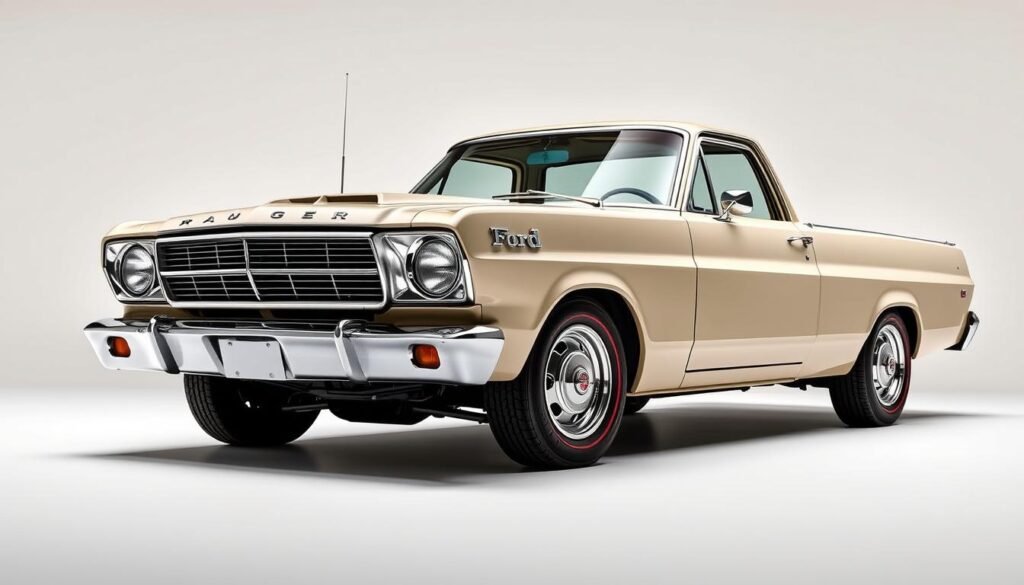
Performance Metrics of Both Models
The Ford Ranchero and Chevrolet El Camino’s performance metrics shed light on what they offer.
By looking at acceleration, handling, and how much they can tow and carry, you can choose the right one for you.
Acceleration and Handling
Driving these classic utes feels different based on their acceleration and handling. The Ford Ranchero moves more quickly because it’s lighter, making it nimble on twisty roads.
However, the Chevrolet El Camino, being a bit heavier, offers a smoother ride which is great for long drives.
Towing Capacities and Payloads
For those needing to transport heavy items, towing capacity is key. The Chevrolet El Camino can tow more than the Ranchero, making it the go-to for heavy-duty tasks.
Despite differences, both have good payload capacities, which can vary by model year. Here’s a look at their performance numbers:
| Model | 0-60 mph (seconds) | Handling (skidpad G’s) | Towing Capacity (lbs) | Payload Capacity (lbs) |
|---|---|---|---|---|
| Ford Ranchero | 8.0 | 0.82 | 3,000 | 1,200 |
| Chevrolet El Camino | 7.5 | 0.75 | 3,500 | 1,300 |
Sales Figures: The Popularity Contest
Sales data for the Ford Ranchero and Chevrolet El Camino show how people’s choices have changed over time.
These numbers help us understand why these cars remain favorites among classic car fans.
Sales Trends Over The Years
The Chevrolet El Camino was more popular than the Ford Ranchero through the years.
With about one million El Caminos sold compared to 500,000 Rancheros. This was due to things like brand loyalty and changing tastes in car design.
Viewer Preferences and Market Dynamics
Viewer preferences had a big impact on sales. The El Camino reached more people because of its look and usefulness.
The Ranchero kept its fans but struggled to keep up with new trends. Things like the economy and what people wanted also played a role in their popularity.
| Vehicle Model | Total Units Sold | Market Appeal Factors |
|---|---|---|
| Chevrolet El Camino | ~1,000,000 | Versatility, design, brand loyalty |
| Ford Ranchero | ~500,000 | Legacy appeal, niche market |
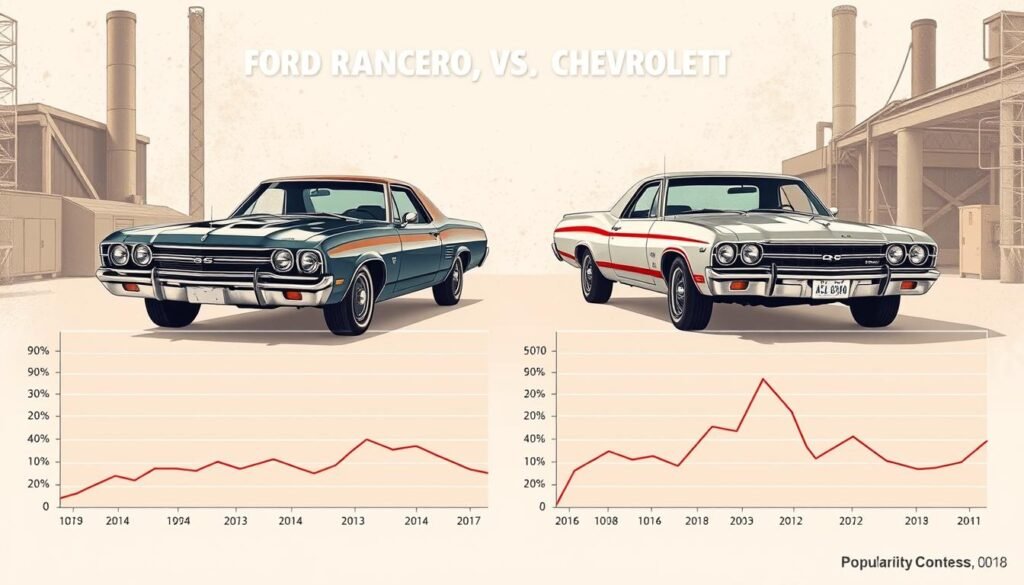
Common Myths About The Ford Ranchero and El Camino
The Ford Ranchero and Chevrolet El Camino are legends among car fans. But, there are myths that might make buyers unsure.
It’s good to know the truth about these special cars. Some people think the Ford Ranchero doesn’t do truck stuff well.
But it was made to work hard, combining car comfort with truck utility. It can tow and carry loads just fine.
The Chevrolet El Camino also has myths. People say it’s not reliable because it looks cool.
But both cars were tested tough before they were sold, making them safe and strong for daily use.
Talking about these cars often misses their impact on car culture. The Ranchero is not just a quirky car; it’s a sign of creativity in car design.
And the El Camino keeps a fan base for its style and power. We need to clear up the myths Ford Ranchero and myths Chevrolet El Camino.
Knowing the facts lets us better enjoy and choose these cars, whether we’re collectors or just fans.
Classic Collector Appeal: Value and Rarity
The Ford Ranchero and Chevrolet El Camino are classic cars loved by collectors. They are known for their value and unique appeal.
Their market prices change depending on their condition, how rare they are, and their model year.
Current Market Values
Looking at the Ford Ranchero, well-kept cars can sell for high prices, especially the rare ones.
For the Chevrolet El Camino, demand is particularly strong for models from the late 1960s and early 1970s.
Hagerty provides detailed pricing insights for these trends:
| Model Year | Market Value Ford Ranchero | Market Value Chevrolet El Camino |
|---|---|---|
| 1966 | $25,000 – $35,000 | $30,000 – $40,000 |
| 1970 | $20,000 – $30,000 | $22,000 – $33,000 |
| 1975 | $12,000 – $18,000 | $15,000 – $20,000 |
Collector Communities and Events
Collector groups help keep the spirit of the Ranchero and El Camino alive. At car shows and auto expos, fans get to display these classics.
There are even special spots just for these two models at events, which helps fans meet and share advice.
Joining these communities is a great way to learn about fixing up or buying these cars.
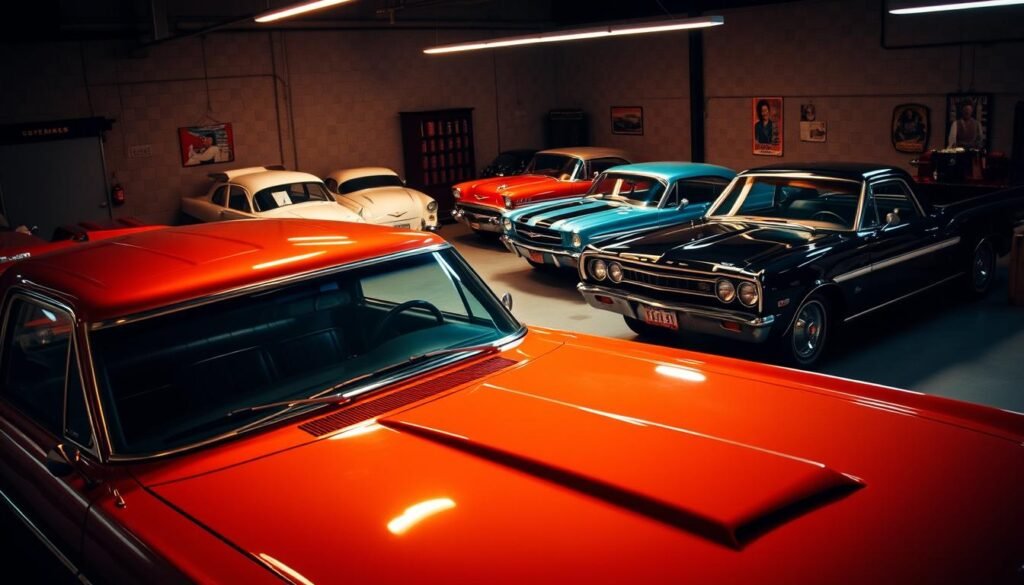
Comparing The Cult Followings
The Ford Ranchero and Chevrolet El Camino are more than just cars. They have huge followings, uniting fans all over the U.S. Enthusiasts meet online and in person, sharing their love for these vehicles.
Fans of the Ford Ranchero help each other with restoration and styling tips. They talk about all versions, from old to new.
People love its mix of truck utility and car comfort. The Chevrolet El Camino enthusiasts are just as passionate. They focus on its unique design and how to make it better.
The deep connection fans have with the El Camino strengthens their community. These followings are key to keeping the cars’ legacies alive.
Car shows and swap meets let fans celebrate and make new friends. This helps ensure the Ford Ranchero and Chevrolet El Camino will be loved for years to come.
Ford Ranchero vs El Camino: Similarities and Differences
The Ranchero and El Camino both offer a mix of utility and style. They have similar coupe pickup designs, merging car and truck features.
Both models sport a sleek, sporty look. Yet, the Ranchero and El Camino have some key differences.
The Ranchero usually has stronger engines, thanks to Ford’s Full-Size car platform. The El Camino, by Chevrolet, is known for its smooth ride and comfy SS trim options.
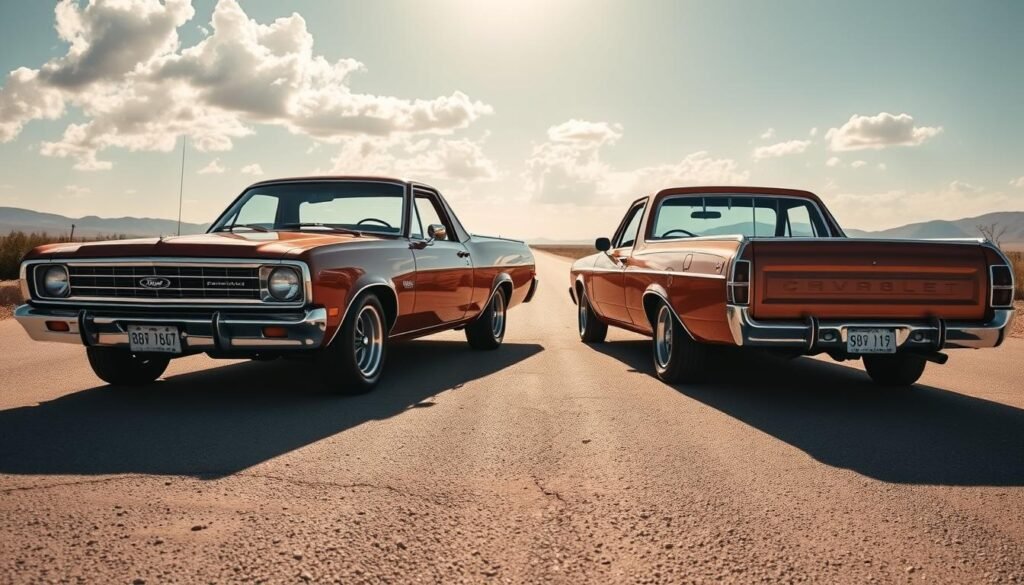
Their performance also sets them apart. The Ranchero excels in hauling with its higher payload capacity.
Meanwhile, the El Camino stands out for its pleasant driving experience, great for everyday use.
| Feature | Ford Ranchero | Chevrolet El Camino |
|---|---|---|
| Body Style | Coupe Pickup | Coupe Pickup |
| Engine Options | Robust engine range with high horsepower | Smoother engines with moderate horsepower |
| Ride Comfort | Sturdy and utilitarian | More refined and comfortable |
| Payload Capacity | Higher payload capacity | Moderate payload capacity |
| Legacy | Strong connection to Ford’s heritage | Solid connection to Chevrolet’s tradition |
Choosing between the Ford Ranchero and Chevrolet El Camino depends on what you value.
Whether it’s performance, comfort, or utility, each has its own charm for different drivers.
Future of The Classic Utes
The automotive world is changing. Classic Utes like the Ford Ranchero and Chevrolet El Camino are coming back strong.
Younger people are finding them cool, marking a new chapter for classic cars. The move toward versatile vehicles is reshaping car trends.
This has sparked interest in coupe pickups again. It hints at the possibility of new models inspired by classics like the Ranchero and El Camino.
The future of these models isn’t clear yet. However, their popularity is bringing people together to celebrate and talk about cars.
These groups help keep the car’s legacy alive and discuss what’s next for car innovation.
| Aspect | Traditional Traits | Modern Adaptations |
|---|---|---|
| Design | Classic lines and styling | Sleeker aesthetics with advanced materials |
| Functionality | Primarily utility-focused | Blend of luxury and practicality |
| Target Audience | Collectors and fans of classic cars | Young drivers seeking unique vehicles |
| Technology | Minimal tech integration | Modern features like infotainment systems |
The way we view classic Utes is changing. This shift in tastes is putting cars like the Ranchero and El Camino in the spotlight again.
Driven by fans and smart engineering, they’re becoming more than old cars. They’re becoming a distinct market trend.
Conclusion
The Ford Ranchero and the Chevrolet El Camino both mark an important time in American car history.
Looking back at their rich past, we see they each have unique stories. The Ford Ranchero blends function and style, and the Chevrolet El Camino merges sportiness with practicality.
This mix attracts many fans. Discussing these cars, we talked about their design, engines, and the love people have for them.
This love shows us more than just fond memories. It’s about their mark on car culture and their era’s innovations.
In thinking about what we’ve covered, decide which car speaks to you more. Maybe you admire the Ranchero’s adaptability or the El Camino’s standout look.
Both have earned their spots in many hearts. They continue to excite both new collectors and long-time car enthusiasts.
FAQs
Q: What are the main differences between the Ford Ranchero and Chevrolet El Camino?
A: The Ford Ranchero is generally lighter. The Chevrolet El Camino has more powerful engines. The Ranchero started as a full-size sedan. The El Camino was built on a Chevelle platform, with unique looks.
Q: Which model has better performance, the Ranchero or the El Camino?
A: The El Camino has a variety of strong engines, known for towing better. The Ranchero’s lighter build improves its handling. It depends on the model year and setup.
Q: How do the sales figures compare between the two models?
A: The Chevrolet El Camino sold almost a million units. The Ford Ranchero sold about 500,000. Sales were affected by people’s likes and market trends.
Q: What engine specifications are typical for the Ranchero?
A: Early Rancheros had a 223 CID I6 engine. They moved to bigger ones like the 352 CID V8. The latest models had a 460 CID V8.
Q: What are the notable engine options available for the El Camino?
A: The El Camino engines ranged from the 348 CID to the 454 CID big-block V8s. This gave it a performance edge.
Q: Are there common myths about the Ford Ranchero and Chevrolet El Camino?
A: Yes. Some myths claim one is always better in reliability or performance. Each has its own strong points. It’s important to know what you need before choosing.
Q: What is the current market value range for classic Rancheros and El Caminos?
A: Market values vary by condition, rarity, and year. Both models can be quite valuable. Prices differ a lot from well-kept ones to those in bad shape.
Q: How do enthusiasts engage with the Ranchero and El Camino?
A: Fans join online forums, go to car events, and meet to share tips on restoring, mods, and their love for these classic Utes.
Q: What does the future hold for classic Utes like the Ranchero and El Camino?
A: Though both are not made anymore, interest in them might grow. People love nostalgia, and trends change. This could spark talks about making similar new models.

